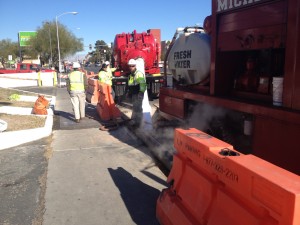June 2014, Vol. 69, No. 6
Features
Pressure Water Pipe CIPP In Vegas

Michels Pipe Services knows quality is not a game of chance, but rather something achieved through experience and ingenuity.
So when Michels was hired by general contractor Las Vegas Paving to rehabilitate 3,400 lineal feet of a 16-inch water main, many steps were taken to make sure the project would be successful. The method specified by the owner was using a cured-in-place-pipe (CIPP) lining system for pressure pipes and meet the drinking water NSF/ANSI 61 Standard.
“Success is never an accident,” said Jason Gubin, Michels project superintendent. “We always put time into developing a solid plan so we are prepared for the job we were hired to do as well as for other variables that might come up along the way.”
The host pipe was an asbestos cement pipe stretched along busy Maryland Parkway from Sahara Avenue to Desert Inn Road, about a mile east of Las Vegas Boulevard. Traffic was extremely heavy and work areas were limited to one traffic lane, including excavations. The project included reinstating 22 service connections that ranged in size from ¾ of an inch to two inches in diameter.
Initially, the work was scheduled to be completed in August, a month during which desert heat can easily top 100 degrees. That searing heat might be welcome when lying by a resort pool, but not when installing heat-sensitive CIPP liners. Plans were developed to cool and protect the resin, liner and job site.
Time change
Ultimately, the timeline was changed to perform the work in November and December when morning temperatures dipped into the 20s. A wet-out facility was established in a warehouse near the job site because epoxy resin suitable for potable water use has a short pot life. The liner was impregnated with the resin, put into an ice bath and stored overnight before being taken to the site and installed the next morning using a traditional air-inversion, steam-cure process.
“This was just another great exercise to show why we never make just one plan,” Gubin said. “We were prepared for everything, which was very beneficial for the customer and for us.”
The project was divided into 14 separate installations with an average length of 243 feet. Las Vegas Paving elected to bypass the entire project at once to speed up the pipe rehabilitation process, and to provide continuous water service to customers during the installations.
Michels used a Sekisui NordiPipe glass-fiber reinforced pipe liner. The stand-alone lining system is designed to withstand high internal and external pressure. NordiPipe is approved for potable water systems and is fully structural. The trenchless CIPP method was a quick, efficient way to rehabilitate the water main and extend its life by about 50 years.
Once installed, the liner was pressure tested to 150 psi.
The 22 saddle connections were robotically sealed prior to installation of the liner and then reinstated after the liner was cured and pressure tested, said Gubin.
Practice makes perfect
Before beginning work in Nevada, the team fine-tuned its techniques in Michels’ yard in Brownsville, WI. Among other operations, the crew tested several methods for setting plugs to make sure they could be easily located and removed after the liner was installed.
“That dedication to developing best practices paid off,” Gubin said. “We went into this project with the confidence that we would do exactly what was needed to get the project done quickly and correctly,” he said. “We knew what would work in those exact conditions and we executed our plan.”

Michels is continuing to evaluate other new water rehabilitation technologies as well, said David Rosenberg, senior manager of Water Rehabilitation Services.
“We never allow ourselves to become complacent and are diligent about developing new ways to improve our work, our methodology and our services,” he said.
FOR MORE INFORMATION:
Michels Corporation, (920) 583.3132, www.michels.us




Comments